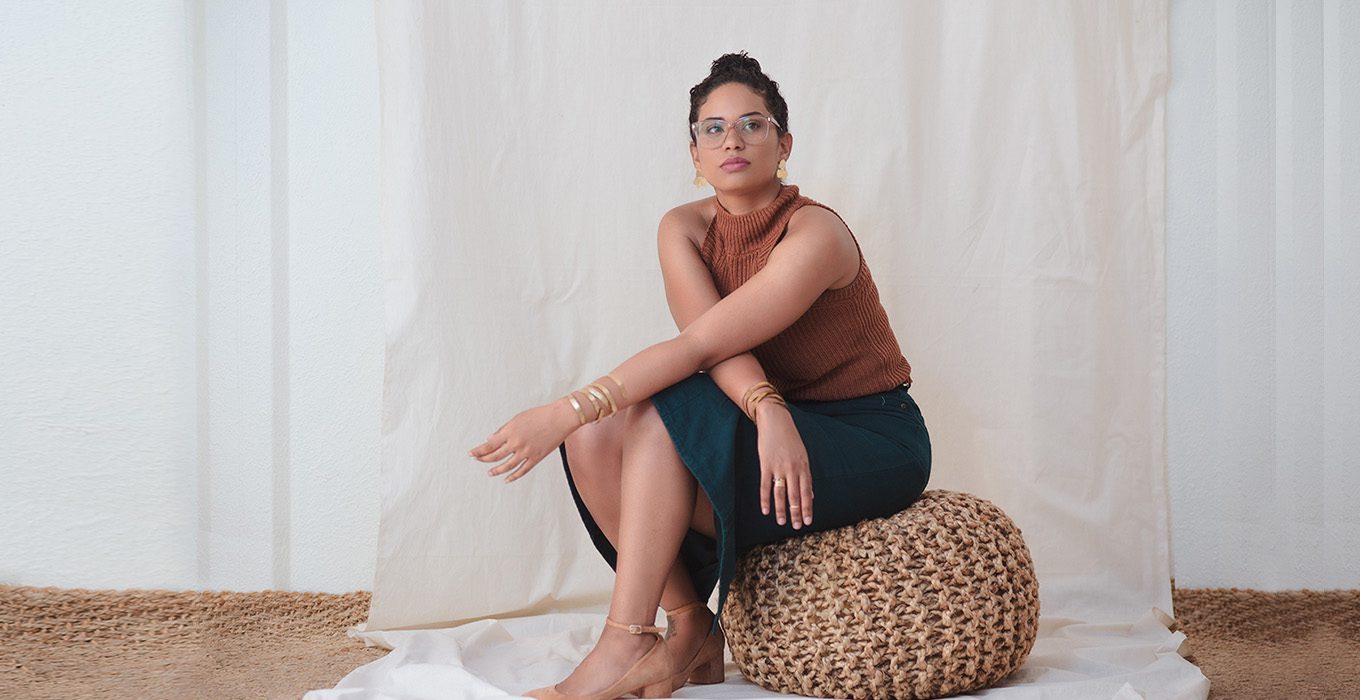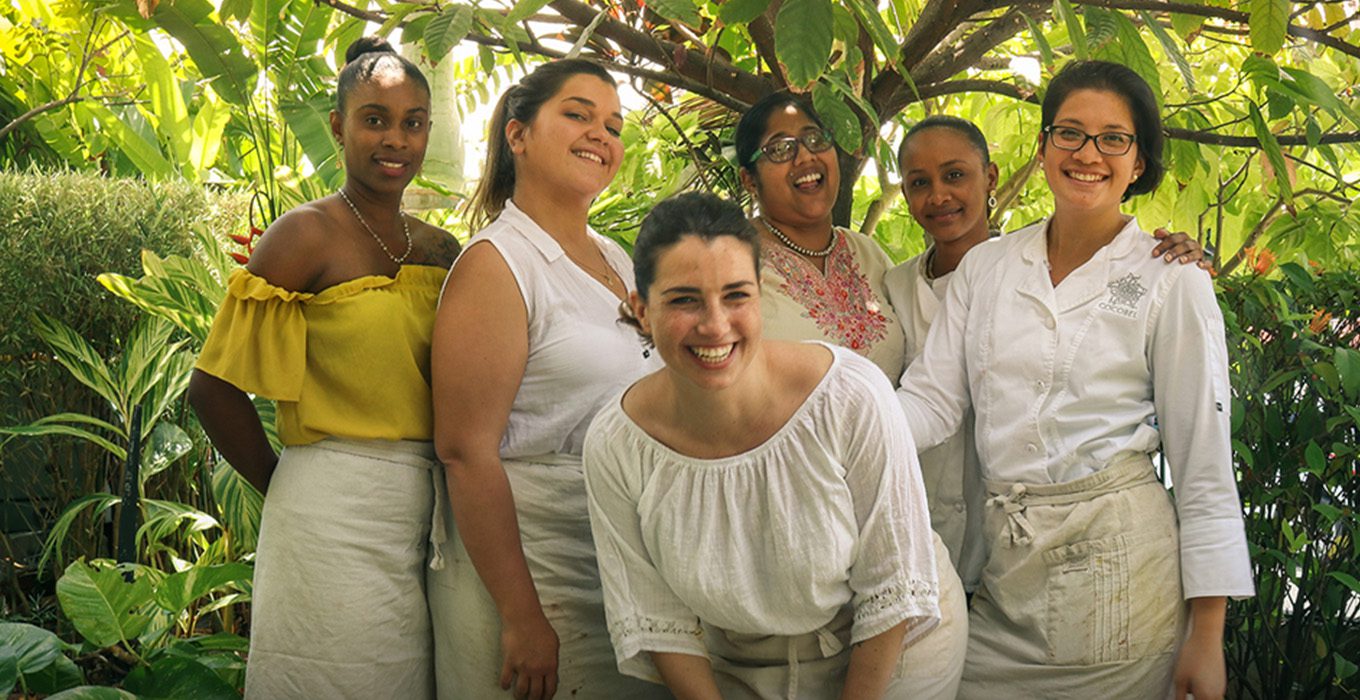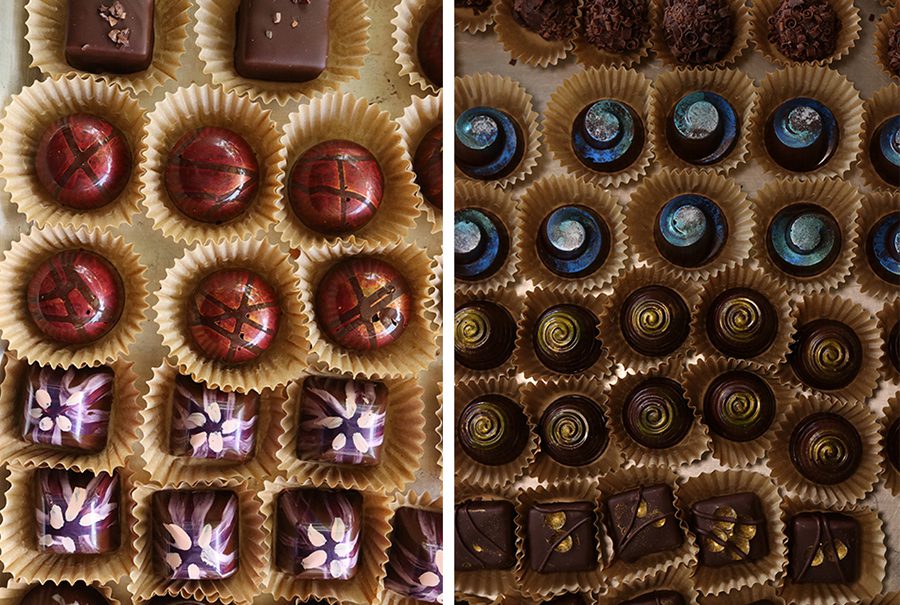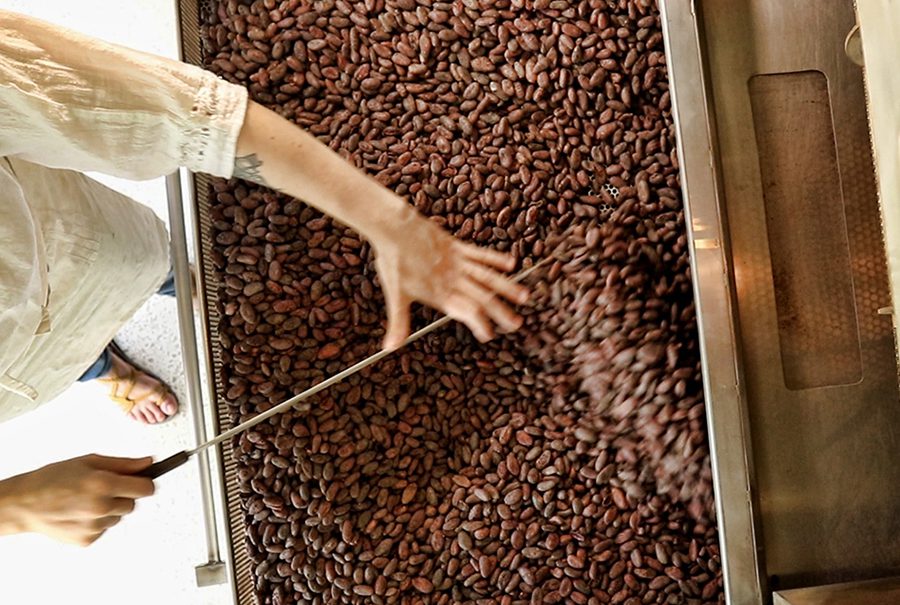

December 06, 2018
From the military to architecture to chocolate, it’s certainly been a unique and unpredictable journey for Cocobel creator Isabel Brash. This sensory designer and chocolatier invited us in to the Medulla Art Gallery on Fitt Street in Woodbrook, where her 2 year old daughter was being entertained by her all female team. There, she shared with us how she was bewitched by the cocoa jumbie, her ability to build memory in to chocolate and her larger, long term plan to use chocolates and her brand as the voice of contemporary Caribbean art. Enjoy!
I’m sure you’ve probably been asked this question a lot, but how did you go from architecture to chocolate?
ISABEL: Well, I actually went to military school first. I was fresh out of high school and wanted a challenge, something with a lot of hard-core physical training, so I chose a small university in Georgia with an ROTC (Reserve Officers’ Training Corps) programme.
I started to think about art and architecture. I wasn’t sure if I was the artsy type but I knew I wanted to be independent. Architecture seemed to be the kind of thing that would allow me to be that – because when you think ‘architect,’ you naturally think ‘smart and stable.’ Ha!
And, after that, what came next?
ISABEL: So, I was at North Georgia College for a year and then transferred to Clemson University in South Carolina where I did my undergraduate degree in architecture. After that, I went to the Bartlett School of Design, which is part of the University College of London, to do my Master’s.
Did you start working in architecture right out of school?
ISABEL: I worked at home, here in Trinidad, between my Bachelor’s and Master’s degrees and then for another three years after graduation. Around 2008, we started to feel the effects of the recession and all of the big jobs started going to international firms. The work here was slow and it was just kinda sad.
That must have been tough, especially so early in your career …
ISABEL: Yes! I needed to stay creative because working as an architect and studying as an architect are two completely different things. So I always had little side projects going, just for fun. I’d rip up shirts and stitch them back together, make trinkets ourt of old magazines, that kinda thing. And it was around that time that I started dabbling in cocoa.
I’ve heard that before, about how different studying architecture is from actually working as an architect. Why is that?
ISABEL: Even my Master’s was completely different from my Bachelor’s. At Bartlett, they really encourage you to push yourself to your limit creatively because they knew that once you got into the working world, you’re not going to have that freedom. Your Master’s is almost like the end of your creative journey.
When you’re studying, you have the opportunity to learn so many different skills and express whatever it is about you that makes you unique in your design. Once you get out there, you’re working for somebody else and, maybe you’re not trying to become famous overnight, but you still want to keep your identity.
You said you weren’t sure if it was the ‘artsy’ part of architecture that you were attracted to, what does that mean?
ISABEL: It’s a very delicate thing – architecture. It’s not like art at all. Art is self-expression. It can be political, but it’s still your opinion. With architecture, you have to keep it in context.
I’m always fighting to balance my architecture side and my ‘free’ side. With art, you kinda loosen up everything but, with architecture, there’s some resistance because there’s a responsibility to the community and the culture. With architecture, this is something you’re building for everybody. You can’t just put up a building that looks like a mushroom in the middle of Woodbrook.
For instance, for Cocobel Chocolate and the Medulla Art gallery, I wanted to include the Woodbrook vernacular and to be sensitive to it, but I’m not going to build something exactly like it was 50 or 100 years ago because the culture’s not the same and life’s not the same.
So, when you were designing the building, were you designing it with chocolate making in mind?
ISABEL: No. It was for architecture and art. When we started building here, I was already seriously into chocolate so I had to change the original kitchen design. But the art was first, and then the chocolate.
Art education has always been a very strong foundation for me but the art world here is so small and the contemporary art world, even smaller. That’s why I use Cocobel as well, as a platform for that discussion. You can’t see it quite yet but it’s getting there.
“The chocolate goes hand in hand with the contemporary artists in Trinidad through the packaging, which is why we used Brianna McCarthy’s artwork on our first chocolate bar. Step by step you’ll see it unfold…”
How do architecture and chocolate come together?
ISABEL: Architecture is about solving problems.
It’s about building, breaking it up, making it better.
Chocolate’s like that for me, as well.
Explain that to us…
ISABEL: Okay, so we have cocoa here, in T&T. My grandfather used to ‘cure’ tonka beans and dry cocoa. He basically worked as a processor for the farmers. They would bring their beans and he would buy them and dry them, if necessary, and then sell them to the Board, who then sold them to whomever. He died before I was born and Dad never spoke to me about it that much until I started playing around with cocoa, so it’s strange how things come back in the next generation.
I’d seen this really beautiful Valrhona chocolate bar from France at a local food festival years ago and always wondered what the process was, to get from this plant, this bean, to chocolate. At first, I assumed that the bars were from Trinidad because there was a picture of the Plantation House from the San Juan Estate on the package, but that’s just where they got the cocoa from.
So I took the Valrhona bar home and tried it and it was amazing. I’d never had chocolate like this before. I knew it was made in France and that the beans were grown in Trinidad and that just stuck in my brain.
“Why isn’t the chocolate made here if the cocoa is from here? It’s our cocoa, we’re selling the chocolate here, but they get to make it. Why are they making it and not us?”
So you started making it?
ISABEL: Yes, I just Googled, “How to make chocolates.”
When I get emails from people asking how to start making chocolate, I always want to ask them if they’ve tried Google. It may sound rude, but that’s how I started! I didn’t have anyone to ask.
Where did you get the cocoa?
ISABEL: My brother had an office in Palo Seco and decided to buy the land that was available next door to it. This is now the Rancho Quemando Estate where Cocobel cocoa is grown.
At first, they weren’t really maintaining the property. It had been abandoned but it still had the cocoa shed on it and some ducks, some chickens and an orchard.
One day I mentioned to my brother that I’d decided to make chocolate but was still trying to figure out where to get the beans. He said, “Well, we have some drying in the shed.” Imagine my surprise! They had cocoa growing on the land he had bought that they were selling to the Board. So he brought me some.
When he brought the bag, that was my first experience with dried cocoa beans but it was also the moment that I knew that I really needed to do something with them.
Walk us through that early process…
ISABEL: Well, the stuff I read online was pretty vague so I was really just playing around and recording whatever I did. I’d taste it but I really had no idea how it was supposed to taste.
I shelled the beans by hand for the first two years. I used to have all my friends around the dining room table shelling the beans and the whole thing was just so exciting – I can’t even describe it!
As a designer, I love making something from nothing – it’s not exactly nothing, though. You’re making something from something that grows from the earth… I think this is one of my favourite things about making chocolate.
I make chocolate purely for pleasure – not for any competitions or anything – so I trust my senses to guide me. If my tongue tells me it’s smooth and I’m getting all the unique flavours I want, I still ask myself, “Can it be smoother? Do I want to preserve this flavour note? Do I want it more refined?” I don’t rely on tools to tell me what is what. It comes down to my intuition and I like that.
I also love that the farmers who ferment the beans, which is so important to the final outcome, they also have that. They have an intuitive role to play, too.
So, when did it really start to come together?
ISABEL: I really just became more and more obsessed… it really is an obsession. It was like the cocoa jumbie had taken over!
When you don’t know something, there’s this overwhelming desire to understand it, to figure it out. I have that desire to figure out almost everything – and definitely with chocolate. So every month I’d get my salary and spend it on a little piece of machinery. I was still living with mom and dad so I made everything out of mom’s little kitchen before I moved to Fitt Street.
You mentioned trusting your senses in your chocolate making process. Does this work for you at all as an architect?
ISABEL: You know, when I was studying architecture, one of my teachers called me a ‘musical director.’ My project was about rhythms: the rhythm of the days and nights, the smells, sounds and movements. All those kinds of things fall into how a city is built. How it smells at certain times of the day. The more sensorial things, you know, like when people start to move, the activities, the beat: that was the whole project. So, yes.
What I’m being told repeatedly from other architects we’ve interviewed is that architecture seems to almost be a sort of an anthropological study of people and space and everything. So you have this wide base of knowledge and designing houses and buildings is only just one part of it.
ISABEL: Yes! It’s creativity…
But also business and hiring staff…
ISABEL: Yes. When you have your own business, you have to bring many people to the table that you don’t necessarily know. It’s difficult – especially when you’ve taken the time to create your space, your sanctuary – but when new people come in, it evolves naturally.
A few of us have been in and out. We have younger people who just wanna learn a little thing and leave, which I don’t particularly like.
When we interview, we tell people that we want to grow a family here. We don’t want to have people just coming in to learn something quickly, take it and go. We want to build and we want everybody to feel like they are Cocobel.
“I want Cocobel to be Trinidad’s brand.”
“I want it to be something that the Caribbean is proud of.”
“I want people to be able to say, “Ah, this is mine!”
Your team is currently all women…
ISABEL: Cocobel has a very feminine look and feeling. It’s the centrality of the brand.
Everything that goes into Cocobel comes from memory and feeling and discovering the way to build that memory into chocolate. It’s a language I’m trying to create from chocolate.
But, to answer your question, we’re a team of eight women and one very important man! Martin is the strongest feminist I know, as well as the guardian of Cocobel’s gates – nothing gets past him! Besides managing the workshop, communications and trying to keep us wild bats in order, he also curates Medulla Art Gallery with Geoffrey MacLean. He is our fiercest brand ambassador! Don’t think you’re leaving this space in his company without a full history on Cocobel and Trinidad & Tobago’s cocoa industry.
Tell me about the rest of your team.
ISABEL: Well, there’s nine of us – Ms. Kia, Shanice, Lydia, Crista, Sandra, Patsy, Alex and Raph in the kitchen. Alex is temporary. She’s currently studying pastry but she’s really focused on chocolates so she’s going back to continue her studies.
Raphaela, who’s my niece, is the wild, free one. She’s been working with me off and on since she was 16 and ‘Fresh Baked Friday’ is more her. She can do anything with cocoa and chocolate but she’s also off to study soon, too.
I’d really like anybody who comes in to be themselves and put themselves into what they’re creating.
I want them to be who they are instead of following how I would do something, which is sometimes hard for me to actually do, to let go, you know. But I have to because then they’re proud of what they create.
The name Cocobel, where did it come from?
ISABEL: I was searching for something that would be indigenous.
Something that was really roots and Patois and slang.
Something that would identify with us, with cocoa and also with something that was sort of magical.
My father was the one to suggest Cocobel because he calls me Bel so he just put the two together. I loved the sound of it but was a little hesitant, at first, because I didn’t want it to be related to my name.
Funny, I never connected the name Cocobel to your name…
ISABEL: Well, that’s great! My dad really liked it and shared the idea with some of his friends from Paramin. They loved it and that’s when I also learned that it means nice, brown ting in Patois.
From that moment on, I was sold! Of course, when people ask me about the name I usually just tell them what it means, which is perfect for chocolate itself but also for our culture, that we’re brown, that we’re all mixed up.
We touched on this a little bit earlier – the Brianna artwork on your first chocolate bar. What made you decide to do that?
ISABEL: So, we had these mini bars before and a lot of people would ask if we had anything bigger, like a traditional sized bar. I’m working on it but I’ve said that for years! I always wanted to design my own bar and have hundreds of drawings for the design. I wanted something soft and organic like a drop of water but also like a central force surrounded by different energies.
Some people look at the finished design and see a vagina. Others see the Egyptian eye, a fish, a bird… It’s floral, it’s very organic and it’s something that is moving and alive. It could be so many different things depending on how you turn it. I love how people see and interpret it.
My sister said something about it the other day that made me laugh. She was complaining about it, which I thought it was great, but what she said was, “You know what I think about this bar? There are no boundaries. It’s like you’re eating it and you don’t know where to stop.”
I thought that was just the best thing! You don’t know where to stop or where to clean it up to finish the edge, so you just keep eating!
And the artwork?
ISABEL: So, the idea for the chocolate bar packaging was that it would feature different local, contemporary artists on it, not just Brianna.
This way, the bar would be able to tell a story and become an ambassador for Trinidad art.
What was it like working with Brianna and creating the Cocobel girl?
ISABEL: When I met with Brianna we talked in length about who Cocobel was because I wanted Brianna to have enough information to create her own impression of the brand.
She did an initial sketch and it wasn’t finished or anything but it was perfect! I loved the wildness of her and she still went ahead to tweak it a bit more but it was always absolutely perfect.
You don’t have to like her and she doesn’t care if you like her or not. She’s a healer. She’s herself. She doesn’t pretend to be anything. She’s Trini, a roots Trini. And she will always be part of our brand.
A lot of Brianna’s art is like that, you know… you can kinda get lost in the art. You see yourself in it, even though it looks nothing like you, and I feel like people really connect with her work.
Where is Cocobel going from here?
ISABEL: I have this vision for Cocobel. It seems like everyone always thinks that getting our stuff out there, overseas, is what you have to do for it to mean anything. For me, it’s more about creating a home for it here – establishing it it properly in Trinidad & Tobago, in this space.
It’s like when you go to France or Italy: you have an espresso in a little cafe. You came for that experience, for the environment, for the rhythm of the city. I want to create that environment here, for both locals and visitors.
And then the packaging is something that you to take with you, to share that experience with someone else. It’s like a language. That’s how I would like to describe the brand.
“It’s like speaking Trini, creating a Trini voice with chocolate. It’s how we speak to people that we can’t actually speak to.”
“I’ll say it again – when people see Cocobel, when Trinidadians and Tobagonians see Cocobel, I want them to feel that it is theirs. I want them to see and feel that it is their own. I want everybody to be proud of it. That’s really the goal.




INTERVIEWER: TANYA MARIE PHOTOGRAPHER + VIDEOGRAPHER: CLAYTON RHULE